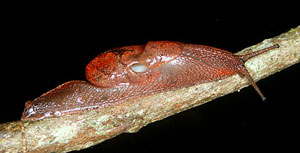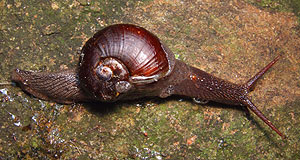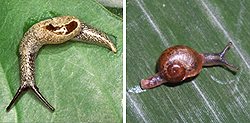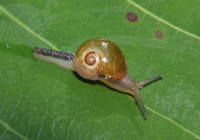Taxonomy

Shells of Ratnadvipia karui (left) and R. irradians (right); scale bar = 5 mm (image: H. Taylor, NHM).
The genus Ratnadvipia, a member of the family Ariophantidae, consists of two species, Ratnadvipia irradians and Ratnadvipia karui, which can be easily distinguished from each other (Raheem and Naggs, 2006).
Shell
The shell of adult R. karui is partly membranaceous, elongately oval (ear-shaped), flat-spired and composed of 2.5 rapidly increasing whorls.
Adult R. irradians, in contrast, have a distinctly more solid shell with 3.5 whorls and a raised spire. The body is generally grey, or brown.
Mantle

Adult of Ratnadvipia karui in life (image: D. Samarasinghe).
The R. karui mantle continues as a broad band around the shell and generally covers all or nearly all of the shell. The inner distal (relative to the genital atrium) surface of the penis is ornamented with dentate transverse ridges, or papillate and/or smooth longitudinal ridges

Adult of Ratnadvipia irradians in life (image: D. Raheem, NHM).
The R. irradians mantle surrounds the shell, and posteriorly forms a very narrow band that is marked by two tongue-like extensions on either side. The mantle only partly covers the shell. The inner distal surface of the penis is smooth.
Juveniles

Juveniles of Ratnadvipia karui (left, image: H. Lokugamage) and R. irradians (right, image: D. Raheem, NHM) in life.
The juveniles of these two species can be easily identified in the field. Both the snail and shell of juvenile R. karui have a flat elongated appearance and the mantle often covers the shell completely or almost completely.
Juveniles of R. irradians have a more spherical, inflated shell. In the young of both species the body tends to be grey.

Juvenile of a Satiella sp. in life (image: D. Raheem, NHM).
Juvenile Ratnadvipia are superficially similar to juvenile Satiella. Juvenile Satiella, however, possess a clear golden, depressed shell, a different arrangement to the mantle and a paler body with a well-defined thin greenish or brownish grey dorsal stripe.